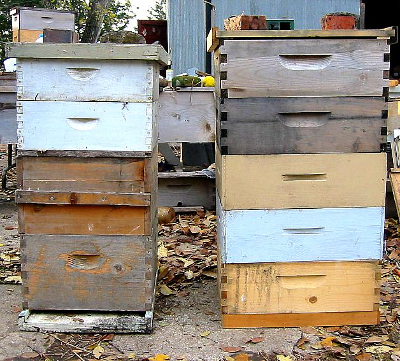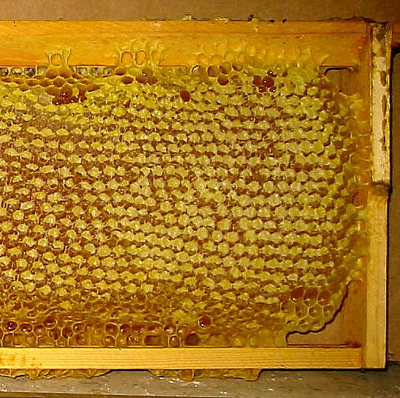
Michael Bush's beekeeping methods
 So what does Michael Bush's
apiary look like? In some ways it's quite traditional --- he
mostly uses Langstroth hives and equipment from mainstream beekeeping
companies. However, he has made a few changes:
So what does Michael Bush's
apiary look like? In some ways it's quite traditional --- he
mostly uses Langstroth hives and equipment from mainstream beekeeping
companies. However, he has made a few changes:
- His boxes are all 8 frame mediums. Since the frames are all the same size, he can move honey and brood around if necessary and can allow an unlimited brood nest. In addition, the smaller boxes are about half the weight of a 10 frame deep, which makes his life much easier. The only downside is cost --- getting started requires nearly twice as much capital with Bush's method.
- He uses foundationless frames. As I've said over and over, foundationless frames help reduce varroa mite problems. In addition, you don't have the cost of buying foundation, the time drain of installing it, and the problematic chemicals that get carried into your hive from someone else's. Although we had a collapse after extracting honey from deep foundationless frames, you won't have problems if you stick to mediums or if you cut and crush.
 He uses top entrances only.
Bush has plugged up his bottom entrances so that his bees go in and out
entrances in the top of the hive. Top entrances means he doesn't
need to worry about mowing around hives or about snow covering the
entrance in the winter. Mice are much less prone to sneak in a
top entrance, and he sees fewer problems from skunks and other pests
too. Finally, top entrances provide good ventilation and, when
combined with a layer of styrofoam on top of the hive, lead to little
winter condensation.
He uses top entrances only.
Bush has plugged up his bottom entrances so that his bees go in and out
entrances in the top of the hive. Top entrances means he doesn't
need to worry about mowing around hives or about snow covering the
entrance in the winter. Mice are much less prone to sneak in a
top entrance, and he sees fewer problems from skunks and other pests
too. Finally, top entrances provide good ventilation and, when
combined with a layer of styrofoam on top of the hive, lead to little
winter condensation.
- He doesn't treat hives.
Except in rare cases, Bush doesn't add any chemicals to the hive.
Even "organic" treatments like thymol
aren't generally on his agenda since these chemicals will kill
beneficial microorganisms in the hive.
- He breeds locally adapted queens.
Rather than buying new queens, Bush raises his own. But even with
these queens on hand, he doesn't requeen a hive unless absolutely
necessary --- for example, if the hive is failing while others are
thriving, or if the bees turn mean. Generally, his queens live to
be about three years old and then are naturally replaced by supersedure.
 He feeds only honey
(usually.) In general, Bush tries to ensure that his bees have
enough of their own honey to make it through the winter. If he
has to feed, he usually feeds honey, but will sometimes feed dry sugar
in a pinch.
He feeds only honey
(usually.) In general, Bush tries to ensure that his bees have
enough of their own honey to make it through the winter. If he
has to feed, he usually feeds honey, but will sometimes feed dry sugar
in a pinch.
- He doesn't scrape anything out of the hive. Bush believes that the burr comb that is sometimes built between boxes is good because it lets you check for mites on drone pupae as you pull it apart, and the intact burr comb gives bees a ladder to climb from box to box. He doesn't cut out swarm cells, instead doing his best to prevent swarms naturally, then splitting hives to raise new queens if he misses the boat and swarm cells do materialize. He also doesn't scrape off propolis, since he believes this processed bee sap kills pathogenic bacteria and viruses in the hive.
Michael Bush's goal is
two-pronged --- he wants to raise bees that don't need chemicals to
stay alive, and he wants his apiary to be as little work as
possible. Those sound like laudable permaculture ambitions to me.
| This post is part of our The Practical Beekeeper lunchtime series.
Read all of the entries: |
Want more in-depth information? Browse through our books.
Or explore more posts by date or by subject.
About us: Anna Hess and Mark Hamilton spent over a decade living self-sufficiently in the mountains of Virginia before moving north to start over from scratch in the foothills of Ohio. They've experimented with permaculture, no-till gardening, trailersteading, home-based microbusinesses and much more, writing about their adventures in both blogs and books.
Want to be notified when new comments are posted on this page? Click on the RSS button after you add a comment to subscribe to the comment feed, or simply check the box beside "email replies to me" while writing your comment.

Fritz --- Michael Bush started out using mainstream Langstroth methods and equipment, so he's retrofitting that to work with his natural methods. As a result, his frames are generally full frames, but you can use the same techniques with just top bars. (You can read more of his foundationless frame info at http://www.bushfarms.com/beesfoundationless.htm.)
Jono --- I should have mentioned that, but going without excluders is almost mainstream, so I forgot. Yes, he skips the excluders and has no problems. Since his boxes are all mediums, it's a simple matter of moving frames around if the queen starts laying where he doesn't want her to. I never had any problem with it even using both deeps and shallows in previous years, but I was also trying to get my bees to have a large brood chamber, so I gave them two deeps.
Yes, he skips the excluders and has no problems. Since his boxes are all mediums, it's a simple matter of moving frames around if the queen starts laying where he doesn't want her to. I never had any problem with it even using both deeps and shallows in previous years, but I was also trying to get my bees to have a large brood chamber, so I gave them two deeps.
Bush did mention in his book that at the end of the winter, the bees often end up at the top of his hive, but he didn't have any problem with that.